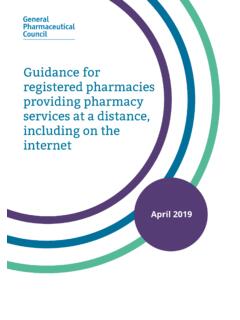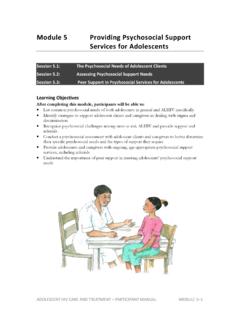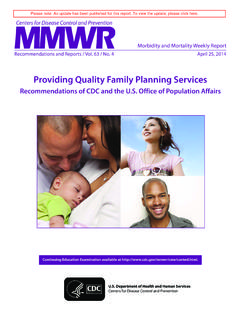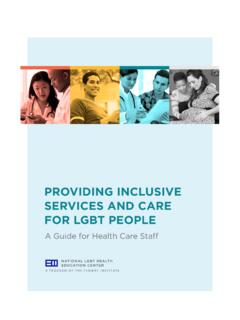Transcription of Providing services for transgender customers - GOV.UK
1 Providing services for transgender customers A guide November 2015 2 Contents Introduction and purpose of guidance 3 Who is this guidance for? 3 Who are transgender people? 3 What is gender reassignment ? 4 Good practice including everyone is good for business 5 What does good practice look like? 5 Good Practice 1: Treat transgender people as you would all other customers whilst considering the additional sensitivities they may face 6 Good Practice 2: Try not to assume someone s gender simply by their appearance 6 Good Practice 3: Consider whether you need to ask someone s gender 7 Good Practice 4: Assume everyone selects the facilities appropriate to their gender 8 Good Practice 5: Accept a range of ID other than a birth certificate you do not usually need to see a GRC to amend personal details 9 Good Practice 6.
2 Ask those who transition whilst using your services how you can support them 10 Good Practice 7: Update documentation and records efficiently and sensitively 10 Good Practice 8: Publicise your good practice and inclusivity to diverse groups 11 The law 12 Equality Act 2010 12 When you may treat people with the protected characteristic of gender reassignment differently 15 Gender Recognition Act 2004 (GRA) 17 Further Resources 18 Glossary 19 3 Introduction and purpose of guidance Every service provider knows that Providing a comfortable, welcoming environment for all customers is key to customer satisfaction and loyalty.
3 This guide is intended to help you ensure transgender people are welcomed, included and valued as customers , clients, users or members, and to ensure they are treated fairly and appropriately. It also aims to help you comply with the law. transgender people, like any other customer , want to shop, open accounts, seek entertainment and go on evenings out, yet they can face discrimination and prejudice in day to day life. Some of it is intentional, most of it is unintentional: the use of the wrong title ( Mr, Mrs, Miss etc.) pronoun ( he, she, they etc.) or being barred from a changing facility. Mistakes like these are easily overcome ensuring that trans customers or clients have a positive experience and service providers are rewarded with future loyalty, business and recommendations.
4 This guidance introduces a range of terms with which you may not be familiar and a glossary is included at the end of this document where these terms are defined. Who is this guidance for? This guidance is for anyone who provides services . This includes those Providing statutory services , voluntary sector services or business / commercial services , as shops, restaurants, public houses, banks, sports clubs and leisure centres. This is general guidance and so may not cover every circumstance you may encounter in your particular service. You may need to take further advice in some situations or if you are unclear what to do.
5 Further resources that can help you are given at the end of this document. Who are transgender people? Although the words gender and sex both have the sense of the state of being male or female , they are typically used in different ways. Sex tends to refer to biological differences, while gender tends to refer to cultural or social ones. A trans person is someone who feels that the sex they were assigned at birth (male or female) does not match or sit easily with their sense of their own gender. Trans people come from all walks of life and include those who may describe themselves as transsexual, transgender , a cross-dresser (transvestite), non-binary and anyone else who may not conform to traditional gender roles.
6 It includes those who have transitioned from male to female ( transgender women) or from female to male ( transgender men) as well as those who do not have a typically male or female gender identity (non-binary). 4 The term assigned gender refers to the gender recorded at birth. Using these words recognises that trans people have had no say in their assigned gender, do not agree with it or do not regard it as a reflection of who they are. It s important to try to avoid phrases such as one of the men who uses our services is turning into a woman or we have a female client who wants to be a man which imply the original assignment was correct.
7 From the trans person s point of view, it is only the outward expression of their gender that is changing, not who they are. Some transgender people choose to undergo gender reassignment . What is gender reassignment ? Gender reassignment is when a person takes steps to alter the outward expression of their gender so that it better aligns with their sense of who they are or, in other words, their identity. This means that if someone adopts a new gender role by changing their name, title and pronoun and/or by wearing different clothing, altering their body language, speech and hairstyle, they have reassigned their gender.
8 As part of their gender reassignment some people may choose to take hormones and/or have surgery, but medical intervention is not an essential part of gender reassignment. 5 Good practice including everyone is good for business All organisations will wish to ensure that they provide the best service for their customers and users to build and maintain their reputation and to ensure customer loyalty. Public sector services need to retain the public s confidence by ensuring that their services include everyone and that service users are treated fairly. services are generally better when they are designed to take account of different people s needs.
9 If you set the atmosphere and culture by treating the inclusion of transgender people as business as usual and nothing remarkable, it will help others to follow. In other words, be mindful of issues that can arise, but don t expect there to be problems. Treating transgender service-users well is cost effective in terms of reputation and business, but also it will reduce the number of complaints, and even in some cases, legal action. [I had] terrible service at [a major high street bank] when I just transitioned getting my accounts changed.. They handled my mortgage, credit cards and bank account all separately so I had the embarrassment of doing it three times.
10 In the end they paid me nearly 200 compensation for the embarrassment.. I left that brand and I tell others of my bad experience. The law specifically protects those with the characteristic of gender reassignment. Good practice means treating everyone respectfully and fairly including all trans people including cross-dressers, those who identify as non-binary, and those who do not conform to gender norms. As well as trans people themselves, their partners, parents, siblings, children, friends and colleagues are likely to favour those services and places that offer a good experience for the transgender people they know.

















